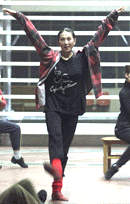 Pink morning clouds shroud the Tibetan mountaintop. The sun has not risen yet and it is cold. Zhroma can see her warm breath curling like smoke in front of her face every time she breathes…
Pink morning clouds shroud the Tibetan mountaintop. The sun has not risen yet and it is cold. Zhroma can see her warm breath curling like smoke in front of her face every time she breathes…
Vultures fly by occasionally. The remains of dead bodies are to be fed to them by funeral workers at dawn in the belief that they take spirits to heaven.
The scene has remained in Zhroma's memory for 30 years. It gives her much inspiration as she rehearses for the dance drama "Riding on Wishes" as the lead dancer.
The drama, directed by Wang Chaoge, is to be presented in Beijing's Poly Theatre from December 20 to 24.
"I am to express my feelings on life and death and my love for my people," said Zhroma. "No one on earth is as close to heaven as we are."
The 35-year-old dancer was born into a Tibetan doctor's family in the plateau's Zetang County and named Zhroma, which means "sacred girl" in Tibetan.
"In my birthplace everyone sings and dances under the blue sky," said Zhroma.
Tibetans dance at any time for any event - at the Great Prayer Festival, or simply after a day's grazing - and boast a great diversity of folk songs and dances.
From historical writings it is apparent that more than 1,000 years ago religious folk dances were popular in Tibet. They influenced the World Bull Dance, Yak Dance, Sorcerers' Dance, Drum dance and other kinds of folk dances handed down and still performed today.
Zhroma has an extraordinary ability to imitate. With her elegant long arms, she was adored as a "goddess of dance" in the snow lands at the age of 12.
In that year she was selected by the Dance Department of the Central University of Nationalities in Beijing, and left the Tibet Autonomous Region.
The girl was thrown into the modern capital.
"Beijing was so large and I was always afraid of getting lost," she recalled.
"For five years I dared not walk from the dining-hall to the dormitory, let alone going downtown.
"People in the city are separated by a layer of glass - you can see them but cannot touch them."
Zhroma was constantly challenged by the urban world's "mystic culture and individuals." When asked to write a composition about "My Ideal," she handed in a blank piece of paper. "It was too removed from how I felt," she smiled.
But Zhroma did find her ideal in dancing. At the university, she was systematically trained in ballet, classical dance and folk dance.
In 1988 she played the leading role in the pas de deux "Qomolangma," which won her gold medals in the nation's Taoli Dance Contest and then Tokyo International Dance Contest.
She then toured 27 countries.
Zhroma soon found people appreciated her dance in their hunt for novelty.
"I will tell them what a great people the Tibetans are," Zhroma pledged, and she did it in "Mother," which was choreographed by Zhang Jigang, one of the country's most inventive choreographers.
Movements in "Mother" are simple, as the dancer bends to the ground and constantly waves her extended sleeves.
Heavily burdened, the mother has a cheerful outlook and quietly accepts all the labor and tears of life.
"I believe in Lamaism and kindness is, in my eyes, the essence of my religion and the best of my people," said Zhroma.
Zhroma tries to portray the soul of Tibetans through her performance as a whole.
Many poses in "Mother" are borrowed from Tangka (ancient Tibetan murals).
Zhroma sticks to the Tibetan lifestyle as well as the religion. Having stayed in Beijing for 20 years, she still lives on tsampa, yak beef and buttered tea.
She returns to her nomadic tent by golden fields of barley many times a year, whenever she feels unhappy.
Having got married several months ago, at the age of 35, she joked: "God is fair to all - but my career is too successful."
After years of ups and downs, Zhroma began pondering over love, desire, time and death.
The dancer found herself always playing a certain role on the stage, and there seemed no way of any other self-expression. She became tired of dancing.
The audience may never have been able to see Zhroma dancing again if she had not met Wang Chaoge, an established female director.
Two years ago, when Wang Chaoge's 93-year-old grandfather died, the old man tried to grasp life in his skinny hands with such eagerness that the director was shocked and began thinking about death.
Zhroma led Wang Chaoge to her hometown - the roof of the world, or the Earth's Third Pole.
There the vultures soared over desolate lands.
In the drama "Riding on Wishes," the vulture is Zhroma's spiritual leader, the thinker.
In the last act, the sun of reason shines on the horizon, the giant feathers of vultures fall from the dark purple sky, and Zhroma unveils and casts a ray of light onto the rolling mountains which symbolize the darkness of human torture.
"My home town is a land without darkness and I'm dancing at your beck and call," said Zhroma.
(China Daily 12/06/2000)
